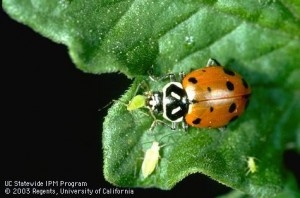Ladybugs love aphids and torch lilies
There is something quite elegant and charming about little red-spotted lady bugs embellishing spring flowers. Make no mistake, however; lady beetles are an aphid's worst nightmare, sucking out their guts, leaving behind empty shells in their wake. Good for people, bad for aphids!
Here are more facts about and reasons we love lady beetles:
What they are: Often referred to as ladybugs, lady beetles are just that: beetles! About 40% of all insect species are classified as beetles; fortunately for humans only a few are considered garden pests.
Why we love them: Lady beetles dine primarily on aphids (and occasionally whiteflies) for free, making them the best pest control you can get.
How to attract them: Avoid pesticides, or try less toxic kinds, to avoid harming ladybeetles and other beneficial insects. Most healthy plants can handle a little aphid damage until the lady beetles arrive to eat them.
Garden centers sell ladybeetles, but there are a lot of variables between how well they were handled, how old they are, “operator error” when releasing, etc. For advice on proper handling of purchased lady beetles, visit the UC IPM webpage here.
How to keep them: Lady beetles generally migrate to the foothills for winter, but are more likely to overwinter in the valley if they have a nice, cozy place to stay and sources of pollen and nectar in the fall to fatten up newly emerged adults for winter hibernation. Good hibernation plants form large, dense, mounding clumps, such as Torch Lily (Kniphofia uvaria) and California native .
For pollen and nectar sources in the fall, try planting late bloomers such as California fuchsia (Epilobium canum) and plants with an extended or “second” bloom season such as Foothill penstemon (Penstemon heterophyllus).
If you have a gardening related question you can contact the UC Master Gardeners at 209-953-6112. More information can be found on our website.